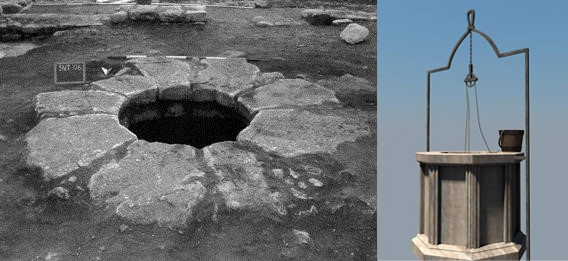The well
The well was essential in the monastery, not just for the water supply but for preparing the monks’ meals, taking care of hygiene, cultivating vegetables and making objects such as pottery (fig. 1).

(photo by Unicity S.p.A.).
The archaeological digs in the courtyard of the San Nicola monastery revealed the exist-ence of a well (figs. 2-3) inside the rock that is several metres deep. The edges of the well were marked by some stone slabs, and inside the archaeologists found many objects, da-ting to the later phases of monastery life. When it was destroyed by fire, the well was turned into a waste dump, as it was no longer useful.
During archaeological digs, no elements were recovered that referred to a protection balustrade (called “archivault” or “ring”), however, it is possible that the well had one, not just to avoid accidental falls, but because if offered a functional resting point while drawing water with a pail, that would be carried out with or without a pulley. Therefore, in the reconstruction 3d of the site, a hypothesis was chosen that may have been the ex-ternal appearance of the ring, although not reinforced by archaeological proof (fig. 2).


Several bone fragments have been found that show signs of butchery, and a large num-ber of whole bones, heads and long bones belonging to adult bovines, but also remains of deer. Not just the meat was consumed from these animals, but the bones and horns were also used to make handles for daggers and items finished off with metal parts.
Bibliografia
- A. BONINU, A. PANDOLFI (a cura di), San Nicola di Trullas. Archeologia, Architettura, Paesaggio, Semestene 2010.
- F. ZAGARI, Il metallo nel Medioevo. Tecniche, strutture, manufatti, Roma 2006.

 VR
VR